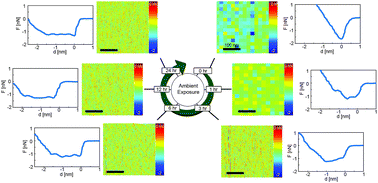Surface aging investigation by means of an AFM-based methodology and the evolution of conservative nanoscale interactions†
Abstract
The divergence in physical properties of surfaces exposed to airborne contaminants in the atmosphere has been widely investigated in recent years, but agreement regarding the role that airborne hydrocarbons and water contamination have on surface property evolution remains elusive. Here we investigate the evolution of a freshly grown highly oriented pyrolytic graphite (HOPG) surface exposed to a controlled environment solely containing airborne water contamination, i.e. water vapor. Our approach combines standard electromagnetic spectrum-based spectrometry methods and atomic force microscopy based techniques to provide a holistic view of the surface properties. We provide evidence of the affect that water adsorption kinetics has on surface properties, interpreting time dependent force–distance profiles and force of adhesion maps directly obtained from the standard observables in a bimodal AFM. To demonstrate the generality of our approach we also apply it to aged calcite surfaces, proving its advantages in providing comprehensive transient characterization of surfaces with sufficient spatial resolution.



 Please wait while we load your content...
Please wait while we load your content...